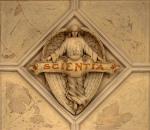
Beewolf Alexander Fleming discovering antibiotics, squiggly lines. Photo: Alvesgaspar
Humans have been aware of the antibiotic properties of some molds and plants for thousands of years. In classical times, fungal molds were used to treat infections. However, the true antibiotic renaissance began in 1928, when Alexander Fleming first isolated penicillin from the fungus,
Penicillium notatum. Since then, penicillin and other powerful antibiotics have saved countless lives and greatly assuaged human suffering.
Antibiotics are biologically-produced chemicals that destroy or inhibit crucial components of microbial pathogens, including bacteria, fungi, and protozoans. Penicillin, for instance, works by inactivating the transpeptidase enzyme in Gram positive bacteria, preventing cell wall synthesis, and eventually killing the bacteria. Another antibiotic, Streptomycin, targets the ribosomes of all bacteria, blocking the binding of initiation factors, and preventing protein synthesis. Each class of antibiotic has a fairly unique mode of action and specific target microbes, allowing their use to be tailored on a cases by case basis.
Considering the benefits of antibiotics, it is unsurprising to learn that other organisms have evolved the means of culturing and applying these potent biochemicals. The classic examples are fungus-growing ants (article). These ants, represented by 200 species within the Attini tribe, grow subterranean fungus gardens which they cultivate for nourishment. In addition, they also culture a third symbiote, a filamentous Streptomyces bacterium that produces antibiotics to protect their fungal gardens from parasitic microbes. The ants grow these microbes on their carapaces and pass them on to their offspring.
Now, research published this week in Nature Chemical Biology, has elucidated a new case of antibiotic micro-culture in Beewolves (Philanthus sp.).
Beewolves are digger-wasps that consume nectar collected from flowers or from honeybees (Apis mellifera); which they squeeze the nectar out of after paralyzing. Female beewolves dig burrows in the ground and lay their eggs on paralyzed honeybees. When they larvae hatch they consume the bee before climbing to the ceiling of the brood chamber and forming a cocoon.
During the several-month gestation in their cocoons, the beewolf larvae are quite vulnerable to infection by microbes. In order to protect her young, the female beewolf cultures a strain of antibiotic-producing Streptomyces philanthi bacteria within specialized glands on her antenna. Prior to her larvae spinning their cocoons, she secretes her Streptomyces cultures onto the ceiling of the burrow. The bacteria are incorporated into the cocoons as the larvae spin them around themselves. The Streptomyces bacteria then excrete antibiotics into the cocoons, protecting the beewolf larvae from harmful microbes.

Left: Female beewolf excreting white Streptomyces bacteria from antennal glands. Right: magnified Streptomyces bacteria from antennal secretions, labeled with a fluorescent probe. Kroiss et al.,2010
Though it was previously shown that beewolves culture Streptomyces to protect their larvae, the nature of the antibiotic protection, provided by the symbiotic bacteria, was unknown. To that end, the current researchers used electrospray ionisation-mass spectrometry and nuclear magnetic resonance spectrometry to identify antibiotics from the beewolf cocoons. Through these ridiculously complicated spectroscopic detection techniques (they may as well be magic as far as I understand them) the researchers identified nine different antibiotic compounds in the cocoons; streptochlorin and eight piericidin derivatives. The researchers demonstrated that these antibiotics where each useful in inhibiting the growth of ten potentially harmful bacteria and fungi microbes. However, the antibiotics were found to be the most efficacious when combined into a complimentary cocktail; as they are found in situ.
The researchers then used imaging mass spectrometry (IMS) to localize the spatial distribution of the three most prevalent antibiotics on the cocoons. IMS works by scanning the surface of an object with an ion beam. This ionizes the chemicals on the object, allowing them to be detected, quantified, and localized with a mass spectrometer. The researchers found that the cocoons had even distributions of the antibiotics over their surface. In addition, they found that the majority of the antibiotics were localized on the outer layer of the cocoon. This led the researchers to hypothesize that the larvae incorporate most of the Streptomyces bacteria early in the spinning process; leaving little left over for the final, internal layers of the cocoon. This has the benefit of keeping the antibiotics on the outside of the cocoon to protect against harmful microbes, while not interfering with the growth of the larvae within.
Beewolves offer a unique case of animals culturing antibiotics for the health of developing individuals. Their antibiotic cocktail approach to microbial control is strongly akin to the synergistic ‘combination therapies’ that are increasingly popular for the treatment of human infections. These techniques have two main advantages: For one, they broaden the effectiveness of the antibiotics to include a wide variety of pathogens. In beewolves, this is advantageous because the developing larvae are threatened by diverse, opportunistic soil and entomological microbes. In addition, antibiotic cocktails are less likely to induce pathogen antibiotic resistance. Against a cocktail, a pathogen would require several simultaneous mutations in order to gain resistance.
The future of human antibiotic treatments are faced with many of the same challenges that the beewolf has risen to meet. In order to solve these problems it is crucial that we also look to nature, as Alexander Flemming did in 1928. Through the trial and error of evolution, beewolves and other organisms have been waging their own antibiotic wars against pathogens for hundreds of millions of years. We would be foolish to ignore their clever solutions to the challenges of surviving on Earth.
 References:
References:
- Kroiss, J., Kaltenpoth, M., Schneider, B., Schwinger, M., Hertweck, C., Maddula, R., Strohm, E., & Svatoš, A. (2010). Symbiotic streptomycetes provide antibiotic combination prophylaxis for wasp offspring Nature Chemical Biology DOI: 10.1038/nchembio.331


















